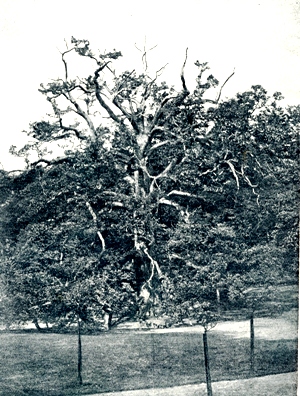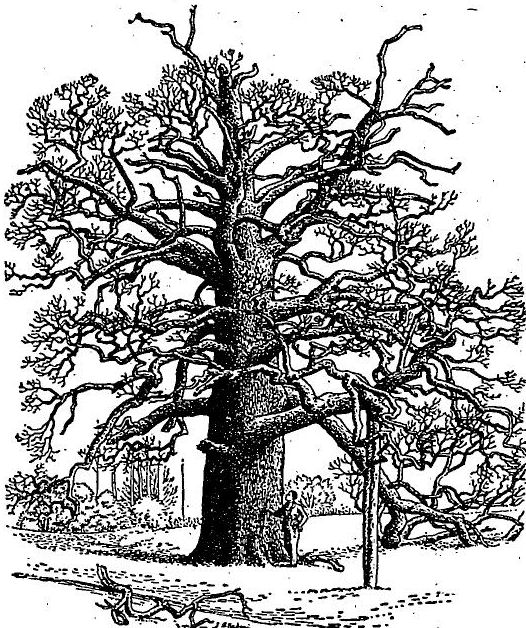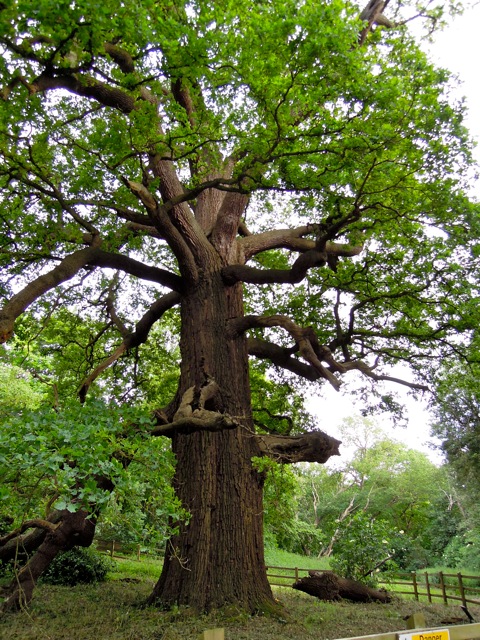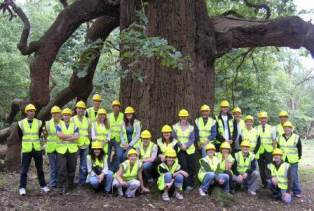|
The Panshanger Oak, Panshanger, Hertingfordbury |
|
A Portrait of a Tree: "The Great Oak at Panshanger" painted by Thomas Medland in 1814. This Famous Tree still stands today and is thought to be at least 400 years old. (Oil on Canvas; 44 by 55 ins.) (Sabin Galleries.) Illustrated London News, 15th January, 1957 |
|
The Morning Chronicle, 24th June, 1831 |
|
Hertford Mercury, 31st August 1841 |
Queen Victoria sees the Oak during Royal visit to Hertfordshire
London Standard, 2nd August 1841 |
by Alex McKenzie
 |
By the kind courtesy of Lord Cowper, I had the privilege of paying a visit to this celebrated tree. For many years we had heard of its wonderful proportions and its great attractions, and after an hour's drive on a lovely spring morning we reached the magnificent domain of the Cowper family.
Entering by the Hertingfordbury Lodge, we drove along the circuitous road amid most charming and diversified scenery, till we arrived near the mansion, close to which and within three hundred yards on its western side, we came in view of this grand old Oak. We found it standing on a lawn, in a hollow, with a sloping bank on all sides, excepting the south, where the ground falls towards the River Mimram, in the valley. Its position is very striking and most deceiving, its immense size not being apparent.
It is a magnificent Tree, and the drawing, by T. Medland, in 1814, was no doubt what the artist then described it to be, "Drawn from Nature, when the Tree was at its greatest state of beauty." In shape it is a truly royal Oak, straight, upright, and taper from root to crown, upwards of fifty feet in height, and the stem is as round as a circle can be drawn.
The height, in 1855, is stated by Mr. Pallett to be seventy-two feet, which I have no doubt was correct. It is surrounded by a fringe of lofty trees that take off from its height, which, at the present time, to the topmost bough, is not less than sixty-five feet.
The western is the fair side of this gigantic Oak, and should be seen by all who pay it a visit. It rather has the appearance as if some years ago it had been struck at the top by lightning, that the lightning passing down on the sunny side of the trunk, made a cleft in about the centre (whence a starling was seen to fly from its nest), and, still passing down, apparently injured a horizontal branch near the ground, afterwards severed from the stem.
The Tree is well supported and preserved, excepting the cleft before referred to, which could easily be protected from further decay.
At five feet high it measures twenty-one feet in circumference, and contains 974 feet, or nineteen loads, twenty-four feet.
Its age is problematical, and it would be interesting to know if any record exists of the planting. I should rather imagine the Tree not to have been planted, but that the acorn, falling into a very rich stratum of loam grew very rapidly. As it contained 315 feet in 1719, it could hardly be less than 200 years old at that date, which would make it 374 years old at the present time. So far as appearances go, and from its shape and size, I believe it may live as long in the future as it has in the past, to be a centre of attraction for many generations.
I have appended the only records I have been able to find of its history, and it is rather singular that, though it has probably been decaying since 1831, it has since then increased two feet in circumference :-
|
Authority |
Date | Circumference 5 ft High | Total Contents in feet |
| 1719 | 315 | ||
| London & Neighbourhood by David Hughson LLD | 1810 | 16 | |
| Hertfordshire, by E W Brayley | 1818 | 17 | |
| T. Medland | 1831 | 19 | 984 |
| M Pallett | 1855 | 796 | |
| A McKenzie | 1891 | 21 | 974 |
After taking a farewell look at the grand old Tree, the visit to which has given us so much pleasure, we are not surprised that so many others find their way there during the summer months to view its fine proportions, and that it remains stamped on the memory, with that pride or glory of possession which we as Englishmen cherish for the" Brave old Oak" which Lord Cowper so kindly and graciously allows the public to go and see.
Hertfordshire Illustrated Review August 1893.
The following account comes from the Hertfordshire Countryside 1946 article Hertfordshire's famous Oaks:
No incident in national or county history attaches to the Panshanger oak, but its fame has been widespread for two and a half centuries. This tree was measured in 1719 and estimated to contain 315 cubic feet of timber. Arthur Young gave its girth in 1804 as 17ft., 5ft. from the ground. A further measurement in 1805 showed the marvellous vigour of the tree, comments the county historian, Clutterbuck, for it then contained 796 cubic feet of timber.
Gilbert White, in his "Natural History of Selborne," names this tree as "probably the finest and most stately oak now growing in the south-east of England."
In 1822 Strutt said it scarcely seemed to have reached its prime, though the spire was already dead. It was then 19ft. at 3ft. above the ground and supposed to contain 1,000ft. of timber. The top of the tree had been killed by lightning, which travelled down the trunk, severing the sinews, so to speak, of one or two of the main branches, and causing them to fall with their extremities on the ground though they still remained alive.
In 1905 the girth was 21ft. 4in. at 5ft., and since then there has been no further growth, though several of the branches still produce foliage and fruit.
Standing close to the base of this tree one receives a quite overpowering effect of majesty as if looking up at some great tower.
On one of his visits to Panshanger Mr. Winston Churchill planted a young oak grown from an acorn of this ancient tree. The Churchill oak is flourishing, and if the longevity of these trees is an hereditary characteristic, it may become a wonder to mankind when the Atomic Age has already receded into the past.
Panshanger Oak, believed to be the oldest oak tree in England, has now been included in a tree preservation order after a recommendation of Hertford rural council's town planning committee. The oak stands to the west of Panshanger House, a former home of the Cowper family for two centuries.
The Times, 15th September, 1953
Sunday Times, 4th January, 1959
The above picture comes from the Panshanger Oak page of the Chilterns Area of Outstanding Natural Beauty web site which records its current girth as 7.60m and describes it as the largest maiden, or clear-stemmed oak in the country.
ß This modern picture of the oak comes from the July 2012 edition of Forest Murmers, the Newsletter of the St Albans Green Belt Association (SAGBA). The online version has additional very informative articles on the Oak by Penny Jones and Peter Reeves written for Forest Murmers in 1999.
| January 2013 | Major update with much new information | |









